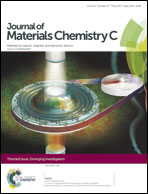Photophysical, electrochemical and solid state properties of diketopyrrolopyrrole based molecular materials: importance of the donor group†
Abstract
Diketopyrrolopyrrole (DPP) based molecular semiconductors have emerged as promising materials for high performance active layers in organic solar cells. It is imperative to comprehend the origin of such a property by investigating the fundamental structure property correlation. In this report we have investigated the role of the donor group in DPP based donor–acceptor–donor (D–A–D) structure to govern the solid state, photophysical and electrochemical properties. We have prepared three derivatives of DPP with varying strengths of the donor groups, such as phenyl (PDPP-Hex), thiophene (TDPP-Hex) and selenophene (SeDPP-Hex). The influence of the donor units on the solid state packing was studied by single crystal X-ray diffraction. The photophysical, electrochemical and density functional theory (DFT) results were combined to elucidate the structural and electronic properties of three DPP derivatives. We found that these DPP derivatives crystallized in the monoclinic space group P21/c and show herringbone packing in the crystal lattice. The derivatives exhibit weak π–π stacking interactions as two neighboring molecules slip away from each other with varied torsional angles at the donor units. The high torsional angle of 32° (PDPP-Hex) between the phenyl and lactam ring results in weak intramolecular interactions between the donor and acceptor, while TDPP-Hex and SeDPP-Hex show lower torsional angles of 9° and 12° with a strong overlap between the donor and acceptor units. The photophysical properties reveal that PDPP-Hex exhibits a high Stokes shift of 0.32 eV and SeDPP-Hex shows a high molar absorption co-efficient of 33 600 L mol−1 cm−1 with a low band gap of ∼2.2 eV. The electrochemical studies of SeDPP-Hex indicate the pronounced effect of selenium in stabilizing the LUMO energy levels and this further emphasizes the importance of chalcogens in developing new n-type organic semiconductors for optoelectronic devices.

- This article is part of the themed collection: Emerging Investigators

 Please wait while we load your content...
Please wait while we load your content...